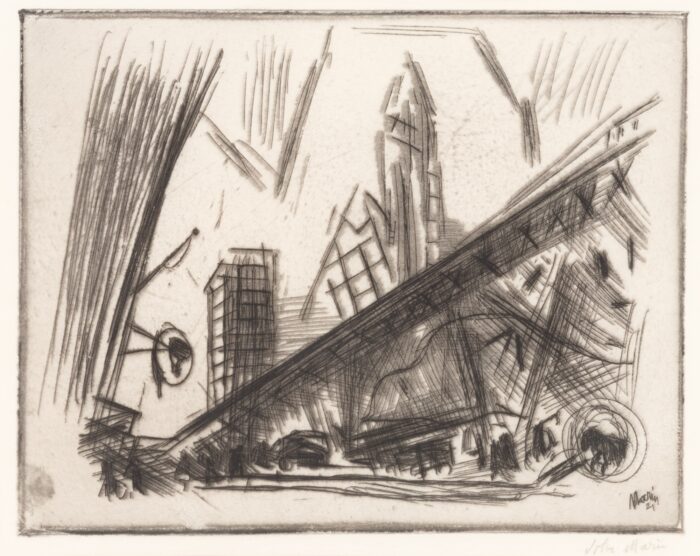Downtown the El, an early proof before steelfacing
Monday, December 11th, 2023John Marin (1870-1953), Downtown, The El, a proof before steelfacing, etching, 1921, signed in pencil lower right; (also signed and dated in the plate). Reference: Zigrosser 134, only state. Published by Alfred Stieglitz, before the edition of about 30 impressions (and before the steelfaced impressions in the New Republic Series, see below). In excellent condition, the full sheet, on firm wove paper, 7 x 9 inches, the sheet 12 1/4 x 13 7/16 inches.
A very fine impression, printed by Marin personally, with strong plate tone, and rich inking left on the platemark framing the composition.
Provenance:
Alfred Stieglitz, An American Place, with it’s label affixed to back of mat.
MKJ Collection (stamp on back of mat; not in Lugt)
G.W. Einstein Company, Inc. (label back of mat)
Zigrosser cites a few other impressions before steelfacing with numbering (1-30) after the Marin signature in pencil, including the impressions at the Metropolitan Museum of Art, and the Detroit Museum of Fine Arts. This impression is presumably a proof before the small pre-steelfacing numbered edition that Zigrosser notes.
Three years after this plate was etched by Marin the plate was steelfaced, and then impressions were printed by Peter Platt and included as part of the Folio of American Etchings by the magazine The New Republic in 1924, in an edition of unknown size but probably around 500 (see discussion below). This impression is 7 x 9 inches, slightly larger than the 6 3/4 x 8 3/4, due to the inking of the borderline, which is not inked in the New Republic impressions.
Initially the New Republic Set, sometimes known as Six American Etchings, contained Marins Brooklyn Bridge No. 6 (Swaying) (Zigrosser 112). But after a small number of sets were completed, Downtown the El was substituted for Zigrosser 112 (and so the number of Downtown The Els in the set would have been a bit fewer than the others in the set). Zigrosser, who apparently had not seen a complete set at the time he created the catalogue raisonne, conjectured that the substitution might have been because the original plate was damaged. But since the printer, Peter Platt, was the most renowned artists printer of his time, and worked alone, it is unlikely that he would have damaged the plate; a more likely possibility is that he switched to a print that was more comparable in size to the others in the set (The Brooklyn Bridge print was much larger), and Downtown The El (printed on a sheet smaller than this pre-steelfaced impression) is about the same size as the others (the other prints were Peggy Bacon: The Promenade Deck; Ernest Haskell: The Sentinels of North Creek; Edward Hopper: Night Shadows; Hayes Miller: Play; and John Sloan: Bandits Cave).
Downtown The El is one of Marins early and influential modernist prints, made after his style changed from the British Etchers/Whistlerian idiom. It has also been called Park Row, and Downtown New York. The El is no longer there, but the building in the center, the Woolworth Building, still stands.
